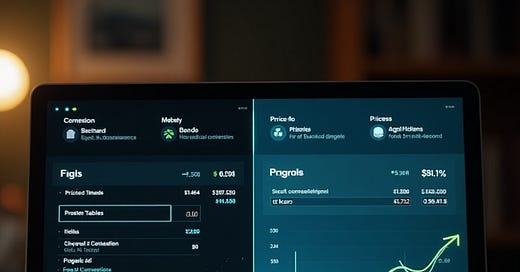Click, Cart, Tariff: How Gen Z Marketers Can Build Bulletproof Pricing Strategies
Why your pricing page might be sabotaging your conversion funnel (and how to fix it).
Hey, it’s Rohit. Welcome to my weekly newsletter on the ever-changing world of digital marketing.
Let’s talk about the one thing most marketers ignore until it’s bleeding revenue: pricing.
Your ads are crushing it. Your landing page looks like it was built by a UX god.
So… why are people still bouncing at checkout?
Plot twist: It's probably your pricing.
Not your CTA. Not your shipping policy. Not your pixel setup.
It’s your pricing strategy — rusty, outdated, and silently killing your conversions.
I’ve coached thousands of marketers over the last three decades. I’ve seen this mess play out more times than I can count: brilliant campaigns, beautiful brands, broken pricing.
Here’s the truth:
Your price isn’t just a number. It’s your brand’s voice, your conversion trigger, and your hidden moat in a world of lookalike products and algorithmic chaos.
Let’s break this down. Especially if you’re a Gen Z or Millennial marketer trying to build something real.
The New Pricing Reality: It’s Not About “Cheap”
Just last month, I was on a call with a DTC founder. Killer product, high retention, polished checkout.
73% cart abandonment. Brutal.
The reason? Her price point felt wrong.
Not too high. Not too low. Just… off.
That’s the part most marketers don’t get:
People don’t leave because the number’s too big. They leave because the number doesn’t match the value story you told them.
We treat pricing like it’s a finance thing.
It’s not. It’s a psychology game. A conversion tool. And increasingly, an SEO lever.
Dynamic pricing is no longer reserved for airlines and hotel chains.
Now, e-comm stores, SaaS startups, and solopreneurs are using tools like Sniffie, Prisync, and Wiser to change prices in real-time—sometimes 50+ times a day—based on competitor pricing, user behavior, and even global tariffs.
But you don’t need 47 tools.
You need a strategy.
Why Most Gen Z Marketers Fumble Pricing
I’ve worked with 5,000+ Gen Z marketers—and let me say this:
You get user experience. You crave authenticity. You build for digital.
But pricing?
That’s where many stumble.
Because pricing isn’t just a decimal decision.
It’s the crossroads of psychology, brand, tech, and market dynamics.
Here’s the five-pillar framework I’ve used with clients across industries to boost conversions by 40–60%, without lowering prices.
Pillar 1: Pricing = Brand Storytelling
Price isn’t just math. It’s a signal.
₹999 tells a different story than ₹1,000 — even if it’s just a buck.
It’s about positioning.
A graphic designer I coached was charging ₹15,000 while others in her niche charged ₹50,000+. She wasn’t attracting budget clients — she was repelling serious ones.
Her price told the wrong story.
Moral? Don’t just pick a price. Pick a message.
Pillar 2: Connect Pricing to the Funnel
Most marketers treat pricing like a tag at the end of the funnel.
Big mistake.
Google’s now factoring price transparency into search rankings.
Yes, your pricing strategy can mess with your SEO.
I’ve seen brands lose 30% of their organic traffic because of inconsistent pricing across their site. Not even kidding.
Pillar 3: Use AI — but Don’t Blindly Trust It
Yes, AI can recommend price points.
But it’s not magic. It’s math.
The real power comes from combining real-time data with human strategy.
Tools like Sniffie and Prisync will spit out optimized price points.
But you still need to gut-check them against your brand promise, your audience’s expectations, and your long-term goals.
Pillar 4: Communicate Value, Not Just Price
Most brands update their pricing and send out a bland “New prices” email.
Yawn.
Here’s what you should be saying:
“Now reflecting global cost savings.”
“Price locked for the next 3 months.”
“Loyalty members save more today.”
That’s value. That’s trust-building. That’s good marketing.
And here’s the bonus: Google loves transparency. Structured pricing data helps with visibility.
Pillar 5: Optimize, Rinse, Repeat
Pricing is never "done."
Markets shift. Algorithms change. Buyer psychology evolves.
A ₹50 tweak can wreck your funnel if it feels off.
Test your pricing like you test your headlines. Weekly. Religiously.
Why Gen Z Will Win the Pricing Game
You were born into dynamic systems. You think in loops, not lines.
That’s your superpower.
Don’t just use dynamic pricing.
Build dynamic pricing thinking into your workflow.
Every ad. Every launch. Every piece of content should sync with your pricing strategy.
Build Your Own Pricing System (In 4 Weeks)
Week 1: Audit
Where does your pricing show up?
Is it consistent? Clear?
Where are people dropping off?
Week 2: Competitive Intel
Track your top 5 competitors.
What do their prices say?
What’s missing in their pitch?
Week 3: Tool Time
Pick ONE AI pricing tool.
Set tracking.
Start testing.
Week 4: Communication
Prep templates for future price updates.
Educate your audience.
Build trust through transparency.
Bottom Line: Price = Trust
Your price isn’t just a tag.
It’s a message. A promise. A first impression.
In a volatile economy, brands that adapt and align win.
Not the cheapest. Not the flashiest.
The ones who get pricing right.
Your Move
Pick ONE pillar.
Test it for 30 days.
Track how it impacts not just sales, but how your audience talks about you.
And if you’re stuck? DM me or drop a comment.
I do free 15-minute strategy calls through my brand, कोंपलें — because sometimes you need fresh eyes on your funnel.
Static pricing is dead.
Time to build something smarter.
Let’s go.




